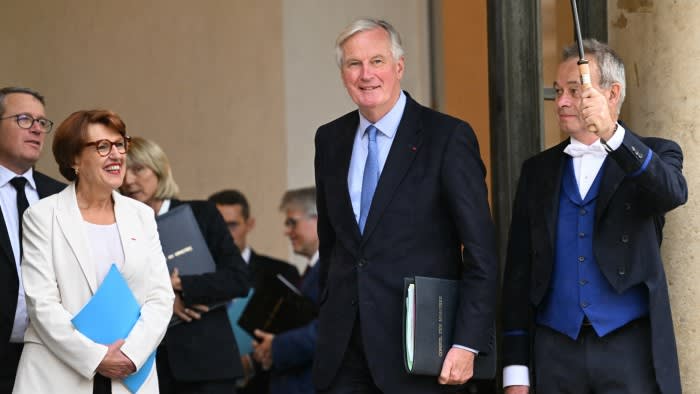Unlock the Editor’s Digest for free
Roula Khalaf, Editor of the FT, selects her favourite stories in this weekly newsletter.
France’s borrowing costs have converged with Spain’s as investors worry about Paris’s ability to close its yawning budget deficit.
France’s 10-year bond yields are trading at the same level Spain’s for the first time since the 2008 financial crisis, at 2.98 per cent, amid investor concerns about rising political and economic risk in France, even as its southern neighbour focuses more on fiscal consolidation.
Meanwhile, the gap between French and German 10-year borrowing costs — seen as a barometer for the risk of holding France’s debt — has reached its highest level in seven weeks. On Tuesday it was 0.79 percentage points, up from 0.71 percentage points at the start of September.
The rising premium to hold French debt came as Prime Minister Michel Barnier’s new government on Monday asked the European Commission for another delay in submitting its plans for compliance with the EU’s fiscal rules.
“French spreads are under pressure as it becomes apparent that the Barnier government faces a difficult future at best, and risk of collapse at worse,” said Mark Dowding, chief investment officer at RBC BlueBay.
Investors are becoming increasingly sceptical that France will implement the budget cuts demanded by the EU, particularly as the rise of populist parties in France and Germany potentially weakens the bloc’s political power to make countries comply with its debt rules.
The European Commission wants to bring public deficits below 3 per cent and public debt below 60 per cent of GDP. France’s debt was 111 per cent of GDP at the end of March this year, while its budget deficit is expected to rise to at least 5.6 per cent in 2024.
“It will be tough for Europe to enforce this . . . where does that leave us? It leaves investors having to force some austerity on the French markets. That’s the worry,” said Kevin Thozet, an investment committee member at French fund manager Carmignac.
Investors are also concerned that Barnier might not be able to stave off a no-confidence vote in parliament in the coming months.
The gap between French and German borrowing costs has almost doubled since the beginning of June, before President Emmanuel Macron called snap parliamentary election, triggering months of political instability as the country grapples with deteriorating public finances.
The European Commission has put France in what it calls its excessive deficit procedure, which places extra scrutiny on the spending plans of Barnier and his new government.
Over the weekend Barnier appointed two ministers reporting directly to him to help craft the budget for 2025 and outline cuts to bring down the spiralling public deficit.
“The debt, economy and political situation in France all justify significant compensation to own French government bonds,” said James Athey, fund manager at investment firm Marlborough.
The latest instability in French markets adds to the blurring of the traditional dividing lines between the bloc’s riskier and safer bond markets.
The spread of the Spanish government’s benchmark borrowing costs over France’s has fallen to around zero from almost half a percentage point six months ago.
“Countries in the periphery, like Spain, continue to perform much better than France,” said Tomasz Wieladek, chief European economist at T Rowe Price. “For now the Spanish political situation is much more stable . . . the economy is also clearly growing.”
Portugal, which was bailed out during the Eurozone crisis, has had lower benchmark bond yields than France’s since June.
Meanwhile, the risk premium on Italy’s debt over France’s has fallen from 1.3 percentage points to close to 0.6 percentage points over the past year.
“If France is unable to address structural issues, it will join Italy in the Eurozone periphery, with the country’s status as a semi-core credit now in doubt,” said Dowding.
Additional reporting by Rafe Uddin in London
https://www.ft.com/content/3d796f47-d548-44b0-95df-d5a31cb029f6


